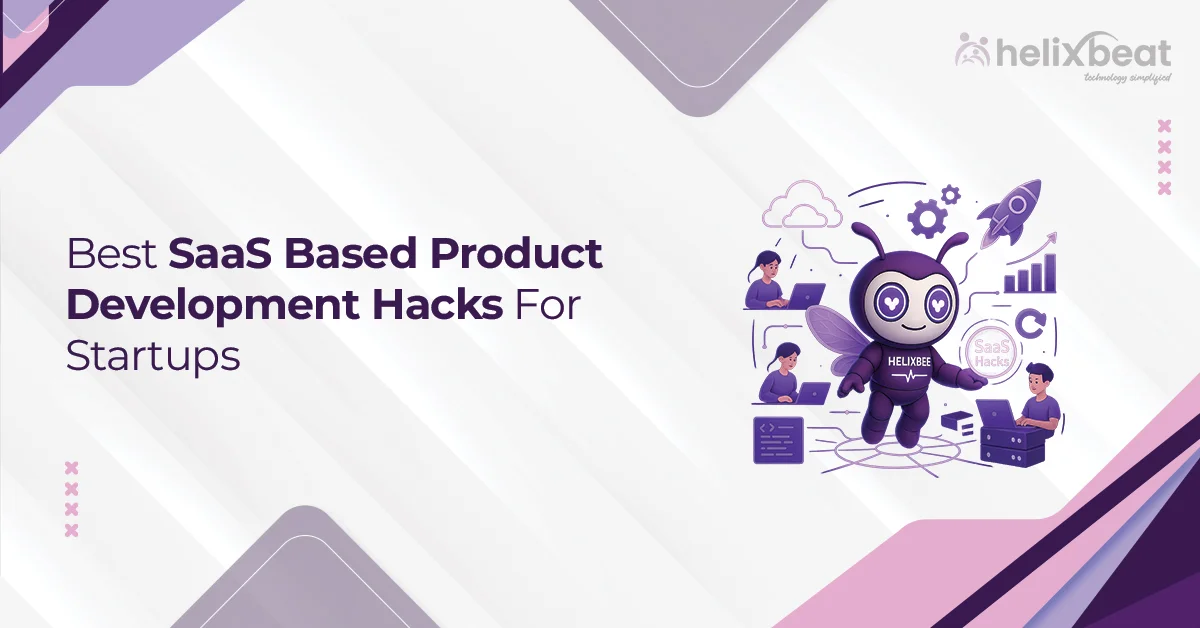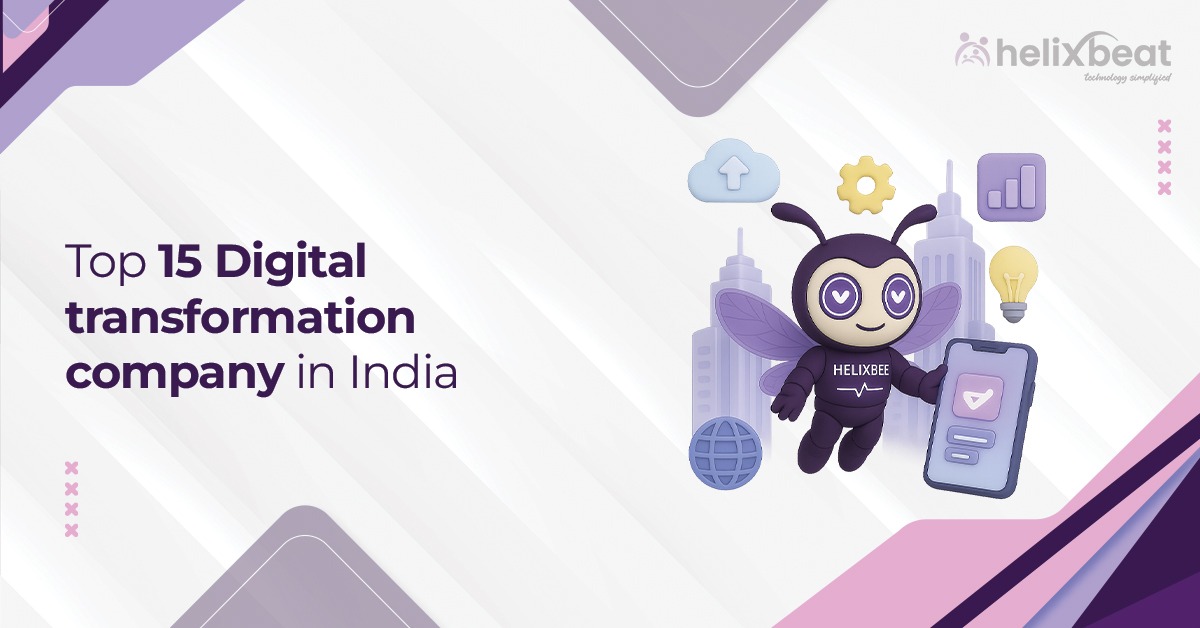Still wondering if your business is future-ready? You’re not alone.
Did you know that 70% of digital transformation initiatives fail—not because of bad tech, but because of unclear strategy and resistance to change? At the same time, digitally mature companies are 23% more profitable than their less digitally evolved competitors. That’s a gap no business can afford to ignore.
We live in a world where customer expectations are constantly evolving. From hyper-personalised experiences to real-time support and lightning-fast service, the pressure is on. And companies that don’t embrace innovation and digital transformation? They risk being left behind.
But here’s the good news: transformation doesn’t have to be overwhelming. With the right mindset, tools, and team, it can actually be both exciting and game-changing.
Let’s break down what digital innovation and digital transformation really means, how you can build a future-proof business model, and how HelixBeat helps companies evolve with purpose.

Table of Contents
What Is Innovation and Digital Transformation?
Let’s keep it simple. Innovation and Digital transformation is the process of integrating modern technology into every part of your business—from how you operate internally to how you deliver customer experiences externally. Think automation, data intelligence, cloud platforms, AI, and more.
But that’s just the “how.”
Innovation, on the other hand, is the “why” and the “what if.” It’s the creative force that challenges the status quo and opens doors to new possibilities:
- What if we could do this better, faster, smarter?
- What if we could offer something our competitors can’t?
- What if our tools could anticipate needs instead of just reacting?
Together, innovation and digital transformation aren’t just about replacing old systems. They’re about reimagining how business gets done. And the companies that get this right? They’re not just surviving—they’re thriving.
Why It Matters Now More Than Ever
The pandemic was a wake-up call, but it wasn’t a one-off. It accelerated what was already happening: the shift to remote work, digital-first customer service, cloud infrastructure, and agile business models.
Now, every industry—whether healthcare, manufacturing, retail, or finance—is undergoing rapid digital evolution. And that transformation is not a “nice to have” anymore. It’s critical to staying competitive.
Here’s what’s changed:
- Customers now expect instant answers, personalized offers, and seamless interactions.
- Employees want modern, flexible tools that empower rather than frustrate.
- Competitors are launching tech-driven solutions that are leaner, smarter, and faster.
If you’re still stuck in manual processes, siloed systems, and outdated workflows, you’re not just losing efficiency—you’re losing opportunities.
The Role of Digital Innovation Strategies
Digital innovation strategies are key to driving transformation by leveraging new technologies to improve processes, enhance customer experiences, and create new revenue streams.
1. Embracing Automation and AI:
Automation and AI are revolutionizing businesses by automating routine tasks, improving efficiency, and reducing human error. AI-driven customer support chatbots handle inquiries and offer personalized recommendations, while robotic process automation (RPA) streamlines tasks like data entry and invoicing. This enhances scalability, reduces operational costs, and boosts service delivery.
2. Integrating the Internet of Things (IoT):
IoT connects devices and sensors to collect real-time data for better decision-making. Industries like manufacturing, retail, and healthcare benefit from IoT by optimizing operations and reducing costs. For example, IoT devices can monitor machine performance in manufacturing, and smart inventory systems in retail ensure efficient stock management.
3. Data-Driven Decision Making:
Data-driven digital innovation strategies help businesses make smarter decisions using predictive analytics. By analyzing big data, companies can forecast demand, identify trends, and personalize customer experiences. E-commerce platforms, for instance, use customer data for personalized recommendations, targeted marketing, and inventory optimization.
Digital Business Model Transformation
Innovation and Digital transformation isn’t just about technology; it’s about rethinking business operations and models.
1. Moving to the Cloud:
Cloud computing offers scalability, cost efficiency, and flexibility. Companies adopting cloud-based systems can quickly deploy solutions, manage resources efficiently, and adapt to changing demands, making them more agile in unpredictable environments.
2. Subscription-Based Models:
Switching from product sales to subscription models generates consistent revenue and builds stronger customer relationships. SaaS platforms are a prime example, enabling companies to offer services without managing on-premise software. Subscription models are also growing in fitness, entertainment, and food delivery industries.
3. Platform Ecosystems:
Platform-based models connect customers, partners, and suppliers, creating new opportunities for collaboration and value. Companies like Amazon and Uber have disrupted industries by offering platforms that facilitate on-demand transactions, broadening market reach and generating new revenue streams
Digital Business Model Transformation: Thinking Beyond Technology
You can’t just throw tech at problems and hope for miracles. True transformation requires a mindset shift—from top leadership down.
That’s where digital business model transformation comes in. It’s about rethinking how your business delivers value, engages customers, and generates revenue in a digital world.
Examples?
- Retailers are moving from physical-only stores to hybrid commerce models with mobile-first digital innovation strategies.
- Healthcare providers are expanding into telehealth and virtual care platforms.
- Manufacturers are using IoT and predictive analytics to enable smart factories.
HelixBeat works with companies to identify new digital revenue streams, redesign customer engagement frameworks, and pivot toward long-term, scalable growth.
Change Management in Digital Transformation: It’s All About People
Although the potential for innovation and digital transformation is enormous, achieving it requires more than just the implementation of new technologies. Effective change management in digital transformation is crucial for ensuring that organizations navigate the challenges of adopting new digital tools and business models while maintaining a productive and motivated workforce.
1. Communicating the Vision: One of the key aspects of change management in digital transformation is ensuring that all stakeholders understand the vision for innovation and digital transformation. Employees, customers, and partners need to be aware of the reasons behind the transformation and how it will benefit them. Clear, transparent communication helps manage expectations and build support for the changes.
2. Providing Training and Support: Innovation and digital transformation often requires employees to learn new skills, tools, and technologies. Offering comprehensive training programs and ongoing support is critical to helping employees feel confident in their ability to adapt. This, in turn, fosters a culture of continuous learning and innovation within the organization.
3. Creating a Digital-First Culture: For innovation and digital transformation to truly succeed, businesses must foster a digital-first mindset across all levels of the organization. This means encouraging employees to think innovatively, embrace new technologies, and collaborate across departments. Creating a culture that embraces change is essential for maintaining momentum and driving long-term success.
4. Measuring Success and Iterating: innovation and Digital transformation is an ongoing journey, not a one-time event. Companies must continuously evaluate the effectiveness of their digital strategies, adjust as needed, and learn from their experiences. Key performance indicators (KPIs) such as customer satisfaction, operational efficiency, and financial growth can help companies measure the success of their transformation and identify areas for improvement.
Transformation isn’t just a tech project. It’s a human journey. And HelixBeat helps organizations lead that journey with empathy, clarity, and confidence.
From Chaos to Clarity: How One Traditional Company Transformed with HelixBeat
For over 20 years, Tradex Furnishings was a proud, family-run B2B furniture business. Their loyal clients—mostly hotels, cafes, and office suppliers—loved the quality of their work. Orders came in via email or phone. Invoices were manually created in Excel. And customer details? Stored across scattered spreadsheets.
It worked… until it didn’t.
The Old Way Was Holding Them Back
By 2022, Tradex hit a wall. The industry was changing fast, and customers now expected real-time service, custom solutions, and seamless digital communication. Meanwhile, Tradex’s sales were dipping, deliveries were delayed, and employees were overwhelmed.
“We had great products and great people, but our systems were all over the place. One small mistake in a spreadsheet, and the whole order could go wrong,” said Kevin Shaw, Head of Operations.
Sound familiar?
- Orders took days to confirm.
- Inventory was tracked manually.
- There was no way to forecast demand.
- Sales and production teams weren’t aligned.
Even worse—competitors were catching up, offering sleek online ordering, personalized dashboards, and faster delivery with automation.
Tradex needed help. That’s when they met HelixBeat.
Enter HelixBeat: Transformation, Done Right
HelixBeat didn’t show up with a one-size-fits-all tech stack. They started by listening.
They asked tough questions like:
- What if your customers could place orders themselves in minutes?
- What if your production team had real-time inventory data?
- What if marketing was backed by real insights instead of guesswork?
And then, they got to work—rethinking how Tradex did business from the ground up.
What Changed? Everything.
Here’s how HelixBeat helped Tradex evolve:
Step 1: Full Audit & Diagnosis
HelixBeat mapped out Tradex’s entire workflow—from customer inquiry to product delivery—and pinpointed what was slowing them down. Turns out, siloed tools and manual processes were eating up hours of productivity every week.
Step 2: Digital Business Model Transformation
Instead of just upgrading old tools, HelixBeat reimagined Tradex’s core approach:
- Set up a customer portal for faster, trackable orders.
- Integrated a cloud-based ERP to manage operations, sales, and inventory in one place.
- Enabled data-driven insights to forecast demand and plan production.
Step 3: Change Management That Actually Worked
Digital tools are only as good as the people using them. So HelixBeat led training sessions, simplified systems, and supported every team through the transition. No overwhelm, just smart upgrades and ongoing support.
The Results? Night and Day.
In less than 9 months:
- Order processing time dropped by 60%
- Customer satisfaction jumped 40%
- Revenue rose by 18%
- Employees felt more in control, less stressed
So, What’s the Takeaway?
Innovation and Digital transformation isn’t about chasing the latest tech trend. It’s about solving real problems, empowering teams, and building a business that can evolve and grow—no matter what comes next.
HelixBeat made that happen for Tradex. And they can do the same for you.
FAQs
1. What is the definition of digital transformation and innovation?
Digital transformation is the process of integrating digital technology into all areas of a business, fundamentally changing how it operates and delivers value.
Innovation is the act of introducing new ideas, processes, or technologies to improve or create value.
2. What is the difference between digital innovation and digital transformation?
Digital innovation is about creating new or improved digital products and services.
Digital transformation is broader—it involves rethinking entire business models and operations using digital technologies.
3. How can digital transformation drive business growth and innovation?
By streamlining operations, improving customer experiences, enabling faster decision-making, and opening up new revenue streams.
4. How does digital transformation contribute to innovation within an organization?
It fosters a culture of continuous improvement, encourages experimentation, and provides tools and data that empower employees to create better solutions.
5. What are the biggest challenges in digital transformation?
Resistance to change, lack of a clear strategy, outdated infrastructure, and limited digital skills are common hurdles.
6. How can businesses start their digital transformation journey?
Begin with a clear vision, assess current capabilities, involve stakeholders, choose the right technology, and invest in change management and training.














